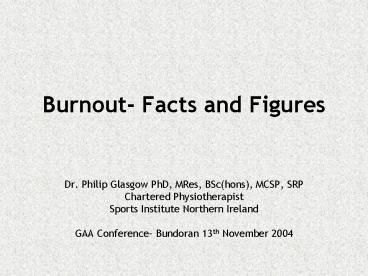Burnout- Facts and Figures PowerPoint PPT Presentation
1 / 48
Title: Burnout- Facts and Figures
1
Burnout- Facts and Figures
- Dr. Philip Glasgow PhD, MRes, BSc(hons), MCSP,
SRP - Chartered Physiotherapist
- Sports Institute Northern Ireland
- GAA Conference- Bundoran 13th November 2004
2
Is There A Problem?
- How Can We Address It?
- Injury Prevention- Theory
- Musculoskeletal Screening
- Results
- Response
- Example of best practice
- Recommendations
3
What is the magnitude of the problem?
What are the causes of injury?
4
- Age (maturation, aging)
- Gender
- Body composition (e.g. body weight, fat mass,
BMD, anthropometry) - Health (e.g. history of previous injury, joint
instability) - Physical fitness (e.g. muscle strength/power,
maximal O2 uptake, joint ROM) - Anatomy (e.g. alignment, intercondylar notch
width) - Skill level (e.g. sport-specific technique,
postural stability)
Predisposed athlete
Internal risk factors
5
CAUSES???
6
Cause?
7
Musculoskeletal Screening
- Identify predisposing factors to injury
- Detect musculoskeletal impairments that may
affect performance - Identify ongoing injuries, which may or may not
be receiving treatment - Provide information to coaches on management of
ongoing injuries - Identify problems not responding to treatment
- Follow up to previous screening
- Put in place appropriate measures to prevent
injury and enhance performance
8
Screening Results
- Postural Alignment
- Joint Range of Motion
- Flexibility
- Stability/Movement Control
- Previous/Current Injury
9
Postural Alignment
- High incidence poor kyphotic posture
- Rounded shoulders
- Poor alignment
10
(No Transcript)
11
(No Transcript)
12
Joint Range of Motion
- Reduced ROM hip joints
- Increase laxity shoulder joints
- Reduced ROM spinal joints especially thoracic
spine
13
(No Transcript)
14
(No Transcript)
15
Flexibility
- Generally poor flexibility
- Reduced hamstring range (45-600 SLR)
- Standard- 90-1200
- Tight hip flexors
- Tight chest muscles
16
(No Transcript)
17
(No Transcript)
18
(No Transcript)
19
(No Transcript)
20
(No Transcript)
21
Stability/Movement Control
- Provides picture of how athlete moves
- Demonstrates effects of static findings
- High incidence poor single leg movement control
tests - Poor gluteal activation
- Poor shoulder stability
- Poor core
22
(No Transcript)
23
(No Transcript)
24
(No Transcript)
25
(No Transcript)
26
Examples of Functional Tests(Video)
27
Current/Previous Injury
- High incidence of ankle and knee injuries
- High incidence hamstring injuries
- High recurrence rate
- Lack of adequate treatment and rehabilitation
28
(No Transcript)
29
(No Transcript)
30
(No Transcript)
31
(No Transcript)
32
Summary of Findings
- Poor Posture
- Decreased Thoracic Extension
- Increased Laxity Shoulder Joints
- Poor Flexibility
- Hamstrings
- Hip Flexors
- Calves
- Lumbar Spine
- Reduced Movement Control
- High Incidence of Previous Injury
- Associated With Ongoing Problems
33
Case Study 1
- 20yr old footballer
- Poor kyphotic posture
- History of right ankle sprains
- History of right hip pathology
- History of right shoulder pain
- Currently complaining of left thigh pain
- Poor balance and proprioception
- Significantly reduced hamstring length
- Unstable right shoulder
- Continued to play throughout injury- still feels
sore (2 years later) - Constantly feels stiff and sore
- Trains 5 times per week
- Regularly plays 3 games per week
34
Case Study 2
- Screening Results
- Dislocated right shoulder
- History of ankle sprains
- Poor flexibility
- Reduced spinal movements
- Very poor posture
- Leg length discrepancy
- Very left side dominant
- Poor single leg control
35
Case Study 2 cont.
- Management
- 4 Months out of playing to rehab dislocated
shoulder - Concurrently worked on flexibility, control,
stability and spinal movements - Outcome
- Returned to full training and competition
- No recurrence of shoulder problems
- Maintained flexibility and spinal movement
- Reports that movement control has contributed
significantly to his game.
36
Case Study 3
- Screening Results
- Very poor kyphosed posture
- Reduced flexibility
- Longstanding quadriceps injury for 6 months that
has not improved despite treatment - Continuing to play
37
Case Study 3 cont.
- Management
- Cessation of playing
- Treatment of injury
- Advanced rehabilitation programme
- Work on flexibility and control
- Outcome
- Return to playing
- No further problems with quad
- Improved flexibility and power generation
38
Conclusion
- In light of the theory of injury prevention, the
significant incidence of intrinsic risk factors
in conjunction with numerous extrinsic factors
(such as training volume and practices), the GAA
squad presents as a High Risk Population
39
How Do We Respond?
- Strategies to reduce injury risk.
- Assessment of training practices
- Content
- Periodisation
- Recovery
- Emphasis on
- Technique
- Postural alignment
- Flexibility
- Stability
- Adequate treatment and rehabilitation of injuries
- Prehabilitation
40
Volleyball intervention study
41
Training program
- Three types of exercises with progression
- Floor
- Airex balance mat
- Wobble board
- 5 weeks 2-4 x each week
- Maintenance 1 x weekly during the season
42
Week 1
Week 4
Week 2
Week 5
43
P0.15 vs. 98-99
P0.06 vs. 98-99
44
(No Transcript)
45
(No Transcript)
46
(No Transcript)
47
Recommendations
- Change training practices
- Volume
- Content
- Periodisation
- Recovery
- Emphasis on
- Technique
- Postural alignment
- Flexibility
- Stability
- Adequate treatment and rehabilitation of injuries
- Prehabilitation
48
Questions

